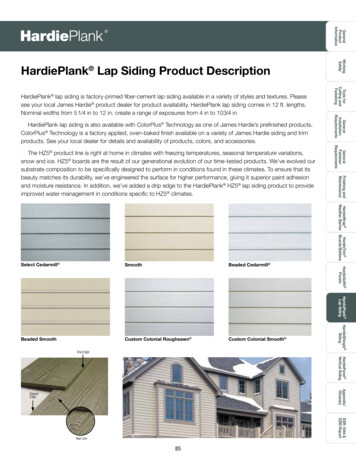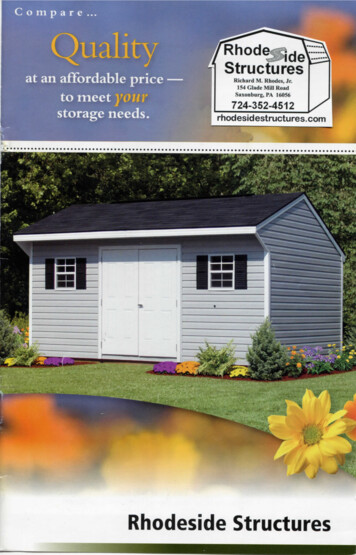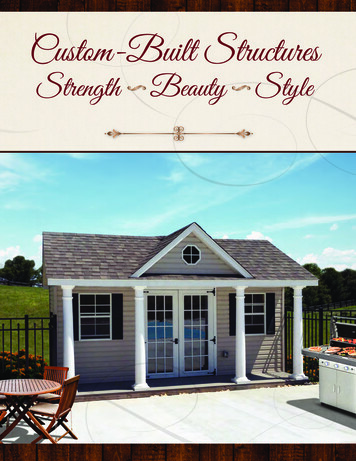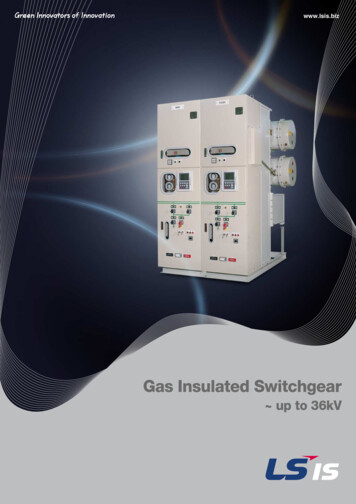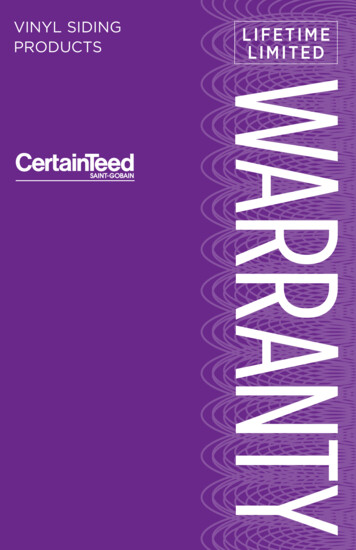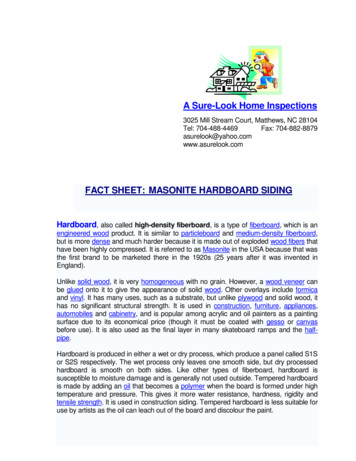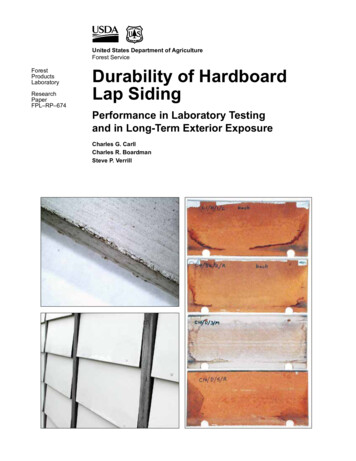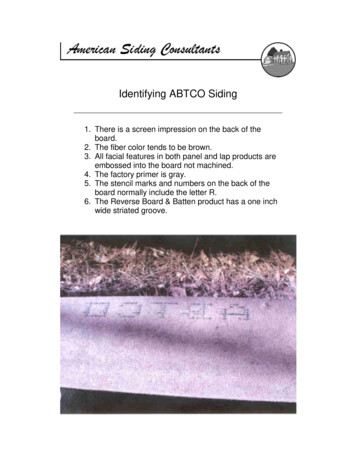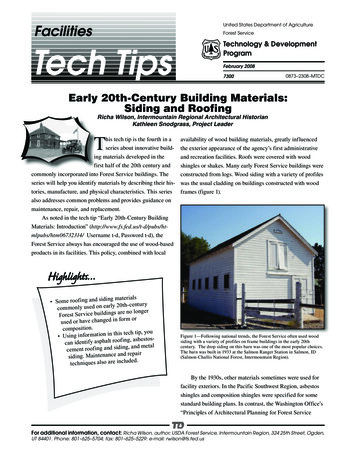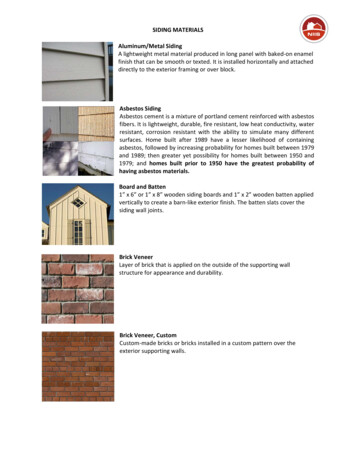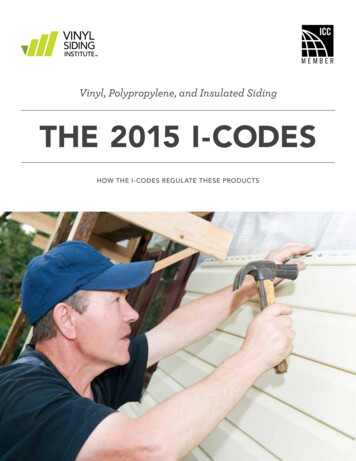
Transcription
Vinyl, Polypropylene, and Insulated SidingTHE 2015 I-CODESHOW THE I-CODES REGULATE THESE PRODUCTS
INTRODUCTIONThis document is designed to help you understand how vinyl siding, polypropylene siding,and insulated vinyl siding are regulated by the I-Codes. It was researched and writtenby the Vinyl Siding Institute (VSI), the trade association for cladding manufacturers.THE PURPOSE OF VSI IS TO FURTHER THE DEVELOPMENTAND GROWTH OF THE VINYL SIDING AND OTHERPOLYMERIC SIDING INDUSTRY BY: Maintaining and expanding markets for vinyl and other polymeric siding. Addressing regulatory issues, including material restrictions, monitoring ofbuilding codes, and the education of building code developers and regulators. Helping develop material, product and performance standards by workingthrough standards-making organizations and code bodies. Sponsoring certification programs that improve the quality of siding and its installation. Providing a forum for issues of interest to the vinyl siding industry. Using VSI resources to share information with the industry and its customerson the benefits of vinyl and other polymeric siding. Engaging in product stewardship and outreach activities to enhance the imageof the industry and its products.
Vinyl Siding, Polypropylene Siding, Insulated Vinyl SidingAMERICA’S #1 CHOICEProperly installedcertified vinylsiding, as requiredby code, canwithstand highwinds, resist heat,cold, and moisture.Vinyl siding, insulated vinyl siding, and polypropylene siding meet the stringentrequirement of building codes across the United States (and Canada). These codesrequire that vinyl siding, insulated vinyl siding, and polypropylene siding be certified totheir respective ASTM standards. This ensures that when manufactured to the appropriatematerial standard and installed properly, they meet the demands of these regulations,such as providing protection from the elements. For example, properly installed certifiedvinyl siding, as required by the code, can withstand high winds – 110 miles per houror more – and resists heat, cold, and moisture. And although the codes don’t addresswarranties, the durability of vinyl siding has enabled vinyl siding manufacturers to offerwarranties that are among the longest and strongest in the cladding industry.ENERGY EFFICIENT Insulated siding, an innovation that has been added into thecodes recently, is vinyl siding with rigid foam insulation laminated or permanentlyattached to the panel. It helps increase the exterior wall’s R-Value and contributes toa home’s energy efficiency by providing continuous insulation making it a great optionfor energy efficiency compliance.CERTIFIED These code-recognized products and colors (although color certification isnot a code requirement) are also certified to meet or exceed industry standards througha program administered by an independent, accredited quality control agency.DEFINING THE PRO DUC T SVINYLSID I N GINSULATED S I D I N GINSUL ATEDVINYL S I D I N GPOLYPRO PY L EN ESI D I N GCladding made principally of polyvinyl chloride (PVC)General category for cladding that provides continuous insulation with an R-Value of 2.0 or greaterInsulated siding using vinyl siding combined with foamplastic insulation, to produce an R-Value of 2.0 or greaterCladding made principally from polypropylene polymer
WHAT ARE THE I - CO DE S?I-Codes providethe regulatoryframework forthe constructionof homes andbuildings.The International Codes, or I-Codes, published by the International Code Council, providethe regulatory framework for the construction of homes and buildings and are adopted byevery state and/or jurisdiction in the United States. Some states will amend the I-Codes, butgenerally speaking, the sections on siding (Chapter 7 IRC, Chapter 14 IBC) are not modified.I-CODES INCLUDE CONSIDERATIONS FOR SOUND CONSTRUCTION ANDSAFE USE OF CLADDING AND ITS ROLE IN PROTECTING AGAINST:WATERBoth bulk and vaporWINDAbility to perform at necessary wind environments dependingon location of building (i.e., coast vs. inland)FIREWhen determined by the code by risk, building size, and occupancytype, be a part of an assembly that provides necessary determined fireprotection and/or performance (i.e., flame spread, hourly rated assemblies,radiant heat release)The four I-Codes that affect vinyl siding, polypropylene siding,and insulated vinyl siding and the buildings they provide regulations for are:International Residential Code (IRC) One- and two-family dwellings,including townhousesInternational Building Code (IBC) Other than one- and two-family dwellings,including apartments and hotelsInternational Energy Conservation Code (Energy Code) Energy efficiencyInternational Wildland-Urban Interface Code (IWUIC)Communities that are built in areas prone to wildfires/forest fires
INTERNATIONAL RE SI DENTIAL CO DEIRC Chapter 7 provides general product and installation requirements for siding.PRODUCT REQUIREMENTS (IRC R703)Products must be certified and labeled to show they conform to their establishedASTM standard:INSULATED VINYL SIDINGASTM D7793POLYPROPYLENE SIDINGASTM D7254VINYL SIDINGASTM D3679INSTALLATION REQUIREMENTSIRC Table R703.3 (1) Provides prescriptive and performance installation requirements:In general, vinyl and insulated vinyl siding are installed 16 inch on center using roofing nails,although variations are allowablePolypropylene siding is typically installed at 16 inches or less on center intervals andmust be installed over some type of wood sheathing, according to the manufacturer’sinstallation instructionsLIMITATIONS In general, vinyl siding, polypropylene siding, and insulated vinyl siding are not limited in theirapplication with homes built under the IRC. In two instances, performance measures related to high density construction and fire will apply. IRC R302 General. IRC Table R302.1 (1) places requirements of a 1-hour-tested assembly according to ASTM E119on exterior walls that are 5 feet or closer to the property line. Vinyl siding is a part of many UL rated E119 assemblies.Polypropylene SidingIRC R703.14.2 places a limitation on the use of polypropylene siding of a 5 feet separationdistance and 10 feet separation for buildings on the same lot. Of course, this provisiondoes not apply to walls that are perpendicular to the line used to determine the separationdistance (example: front and rear elevations of townhouse construction).
INTERNATIONAL BUIL DING CO DEIBC Chapter 14 provides general product and installation requirements for siding.PRODUCT REQUIREMENTS (IBC 1404)Products must be certified and labeled to show they conform to their establishedASTM standard:Insulated Vinyl Siding isnot recognized in the IBC.Building officials may relyon code compliance reportsfor verification based on theestablished standard for theproduct category ASTM D7793.INSULATED VINYL SIDINGPOLYPROPYLENE SIDINGASTM D7254VINYL SIDINGASTM D3679INSTALLATION REQUIREMENTSIBC 1405 provides prescriptive and performance installation instructionsIn general, vinyl siding is installed 16 inch on center using roofing nails, althoughvariations of this can be donePolypropylene siding is typically installed at 16 inch or less on center intervals andmust be installed over some type of wood sheathing, according to the manufacturer’sinstallation instructionsLIMITATIONS In general, the use of vinyl siding is allowed in Type V and V-B construction and other types ofconstruction when certain test results are demonstrated according to IBC 1406. Vinyl siding is allowed on buildings where the ultimate wind speed does not exceed100 mph and the building height is 40 feet or less. Note: If the building exceeds theseconditions then documentation may be provided to show necessary adequate performance. Polypropylene siding has the same limitations as vinyl siding, except it is only allowed onType V-B construction. Insulated vinyl siding limitations will be listed in the code compliance report. IBC Table 602 and IBC 705.5 place certain fire resistive ratings on walls depending on theoccupancy, type and size of building based on ASTM E119 tests. Vinyl siding is a part of many UL rated E119 assemblies. In addition vinyl siding is allowedto be part of IBC 722’s calculated fire resistive approach. IBC 1406 allows the use of vinyl siding (and other combustible cladding) with Types I, II, III, IV undercertain conditions as long as its application is 40 feet or less height above plane. If combustible vinyl siding is used with Types I, II, III, IV construction, it must be tested inaccordance with NFPA 268 (IBC 1406.2.1.1) and perform to certain levels depending onthe fire separation distance (density) of the building.
ENERGY CO DE & IW UICInsulated sidingcan be usedto meet theR-Value/U-factorrequirements ofthe IECC.INTER N ATION A LENERGY CONSER VATION CO DEThe IECC prescribes insulated siding as a building material that can beused as continuous insulation outside of the building framing to provide therequired total wall R-Value.Insulated siding can be used to meet the R-Value/U-factor requirementsof the IECC.IRC N1102.1.3 (R402.1.3) of the 2015 IECC allows the R-Value of insulatedsiding to be used as part of the prescriptive R-Value computation approach andmay be used to satisfy the R-Value insulation requirements of IRC N1102.1.3(R402.1.3) Table 402.1.2.INTER N ATION A LW IL DL AN D - UR BAN INTER FACE CO DEVinyl siding is allowed for use under this code in all conditions with certainperformance requirements.IWUIC Table 503.1 shows that there are three different types of risk categoriesthat impact the requirement for the type of Ignition Resistant (IR) wallconstruction. In the most stringent IR wall construction (IR1 and IR2) vinyl sidingmay be used so long it is a part of a 1-hour UL E119 rated assembly and canexhibit a flame spread index no greater than 25. When an IR3 condition applies,there are no requirements on specific type of wall construction or cladding.
Code Specifications ReviewQUICK REFERENCE CHARTV INY L SIDINGINSUL AT ED VINYL SIDINGPOLYPROPYLEN E SIDIN GPRODUCT REQUIREMENTS (IRC R703)Products must be certified and labeled to show they conform to their established ASTM standardASTM D3679ASTM D7793ASTM D7254INSTALLATION REQUIREMENTSIRC Table R703.3 (1) Provides prescriptive and performance installation requirementsI N T E R N AT I ONALR E S I D E N T I A L CO DEIn general, vinyl siding isinstalled 16 inch on centerusing roofing nails, althoughvariations of this can bedoneIn general, insulated vinylsiding is installed 16 inch oncenter using roofing nails,although variations of thiscan be doneTypically installed at 16 inchesor less on center intervals andmust be installed over sometype of wood sheathing,according to the manufacturer’sinstallation instructionsLIMITATIONSIn general, vinyl siding, polypropylene siding and insulated vinyl siding are notlimited in their application with homes built under the IRC.IRC R703.14.2 limits the use ofpolypropylene siding in certainhigh density applications.PRODUCT REQUIREMENTSProducts must be certified and labeled to show they conform to their established ASTM standardASTM D3679Not Recognized*ASTM D7254INSTALLATION REQUIREMENTSIBC 1405 provides prescriptive and performance installation instructionsI N T E R N AT I ONALB U I L D I N G CO DEIn general, vinyl siding isinstalled 16 inch on centerusing roofing nails, althoughvariations of this can bedoneNot Recognized*Typically installed at 16 inchesor less on center intervals andmust be installed over sometype of wood sheathing,according to the manufacturer’sinstallation instructionsLIMITATIONSIn general, the use of vinyl siding is allowed in Type V and V-B construction and other types ofconstruction when certain test results are demonstrated according to IBC 1406.Allowed on buildings whereultimate wind speed doesnot exceed 100 mph and thebuilding height is 40 feet orless.***INTERNATIONAL ENERGYCONSERVATION CODEINTERNATIONAL WILDLANDURBAN INTERFACE CODEWill be listed in the codecompliance reportSame limitations as vinyl sidingexcept it is only allowed onType V-B constructionCan be used as continuousinsulation outside of thebuilding framing to meetthe R-Value/ U-factorrequirements**Vinyl siding is allowed for use under this code in all conditions with certain performance requirements.* Building officials may rely on code compliance reports for verification based on the established standard for the product categoryASTM D7793** IRC N1102.1.3 (R402.1.3) of the 2015 IECC allows the R-Value of insulated siding to be used to comply with the energy code.***If the building exceeds these conditions then documentation may be provided to show necessary adequate performance. IBC Table602 and IBC 705.5 place certain fire resistive ratings on walls depending on the occupancy, type and size of building based on ASTME119 tests.
NATIONAL HOUSING CENTER1201 15TH STREET MW. SUITE220 WASHINGTON, DC 20005FOR MORE INFORMATIONVISIT VINYLSIDING.ORG
* Building officials may rely on code compliance reports for verification based on the established standard for the product category ASTM D7793 ** IRC N1102.1.3 (R402.1.3) of the 2015 IECC allows the R-Value of insulated siding to
